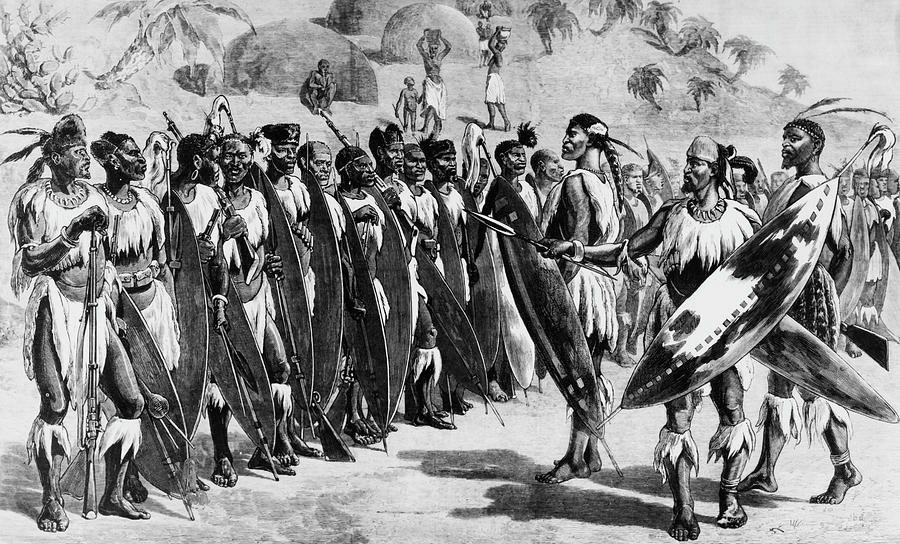By Thomas Sibanda – Mzal Tom
After the acrimonious fall out with Shaka, King Mzilikazi and his people crossed over uKhahlamba/Drakensberg mountain range. They then temporarily joined forces with Nxaba a chief of the Nguni Msene around 1822-23.
However, Nxaba and his people later joined forces with Ngwana Maseko and trekked to the newly founded kingdom of Soshangane. Mzilikazi decided to remain in the then Transvaal.
After parting with Nxaba, Mzilikazi was was given refuge by King Sibindi of Amanala clans of the amaNdebele. He trained their young people to become warriors. One day when the young men were sent out on raiding missions, Mzilikazi assassinated Sibindi.
He then recruited the young fighters to join him and many were captured and incorporated into his growing military regiments. King Mzilikazi’s next target was the Ndebeles who were under King Magodonga Mahlangu known as amaNdzundza who lived near Middelburg.
King Magodonga Mahlangu was reputed for having magical powers which King Mzilikazi could not match Magodonga was able to get himself submerged under water with a flaming firebrand and emerge after a while with the brand still alight.
Mzilikazi managed to defeat Magodonga with the help of his senior inyanga Mphubane Mzizi. Mzizi kept close watch over Magodonga and managed to collect a small portion of his faeces. Mzizi then mixed the faeces with strong roots and portions.
This concoction caused Magodonga’s magic to vanish. Mzilikazi thereafter attacked Magodonga and his army successfully. Magodonga was then executed. The bulk his people were joined Mzilikazi and the men were conscripted into a regiment called iZimpangele.
It is in the Middelburg area that Mzilikazi built his first capital which he called Ekuphumuleni. By then, the population of his people was augmented by other Nguni refugees amaHlubi, who had settled in the area, running away from the violence of the emerging Zulu empire.
Mzilikazi settled for a while at Ekuphumuleni. However, the Griqua (Cape coloureds) cattle raiders raided the Ndebele of their cattle. They were skilled fighters who had firearms and horses. After heavy losses, around 1827, Mzilikazi decided to move northwards.
He moved northwards through Magaliesberg and Kommandonek near the present Hartbeespoort Dam. At this point, he had defeated and incorporated the Sotho-Tswana of the western high veld. These included the Pedi of Thulare, Hurutshe, Ngwaketse, Kwena and Khudu.
Mzilikazi established temporary settlements near present-day Rustenburg. From this base he attacked baKwena at Silkaatsnek. However, he failed to defeat them. Thereafter, he changed strategy and launched attacks on the Po who were easily defeated.
The chief of the Kgatla, Chief Pilane successfully fled to the hills. Mzilikazi then conquered and assimilated other Tswana groups that remained in the area. Using the Magaliesberg as his centre, Mzilikazi expanded his kingdom.
By then his kingdom stretched from the Vaal River in the south to the confluence of the Crocodile and Limpopo Rivers. Between 1827 and 1832, Mzilikazi built himself three military strongholds. The largest was Enkungwini.
Enkungwini was situated at the foot of the Wonderboom Mountains on the Apies River, just north of present day Pretoria. Another was Endinaneni, north of the Hartbeespoort Dam, while the third was Mhlahlandlela in the territory of the Fokeng near Rustenburg.
By 1829, the total Ndebele population was estimated at around 70, 000, consisting of the Nguni nucleus and 80%, who were assimilated Sotho-Tswana-Pedi groups.
In 1830, Mzilikazi had a visit from Robert Moffat, the Scottish missionary who worked among the Sotho-Tswana people. In the same year Dingane’s Zulu regiments launched an attack on Mzilikazi. However, three Zulu regiments were defeated.Moffat became very close to Mzilikazi.
Early in 1832, the Ndebele defeated the Rolong Tswana group.They further conquered and subdued Hurutshe, whose capital was Mosega. Mosega became Mzilikazi’s critical southern military headquarters guarding the route to Kuruman.
At Tshwenyane, he built another military stronghold, and near the Great Marico River, a massive royal capital of iGabha or eGabheni.The Afrikaaners pronounced it as Kapain. The other setttlemet that was established close to eGabheni was known as uMkhwahla or eMkhwahleni.
The demise of Mzilikazi’s kingdom south of the Limpopo was due to the 1836 eastward migration of disgruntled Dutch settlers / voortrekkers who travelled from the Cape Colony into the interior of modern South Africa seeking freedom from the Cape’s British colonial government.
These Dutch groups launched attacks on the Ndebele seeking to displace them. In November 1837, the Dutch groups of Potgieter, Maritz and Uys launched the final attack. In a battle lasting 9 days, they annihilated eGabheni as well as other Ndebele camps along the Marico River.
Fearing complete annihilation by the Dutch who had gained full control of the then Transvaal Mzilikazi moved much further north on the advice of Robert Moffat . By early 1838 Mzilikazi and his people had moved out of the Transvaal northwards across the Limpopo River.
Follow the History & Heritage channel on WhatsApp for my pre-colonial Zimbabwean and Southern African History articles, pictures, video presentations, materials and links: https://whatsapp.com/channel/0029VaejGC3It5s2uGSYbL1r

